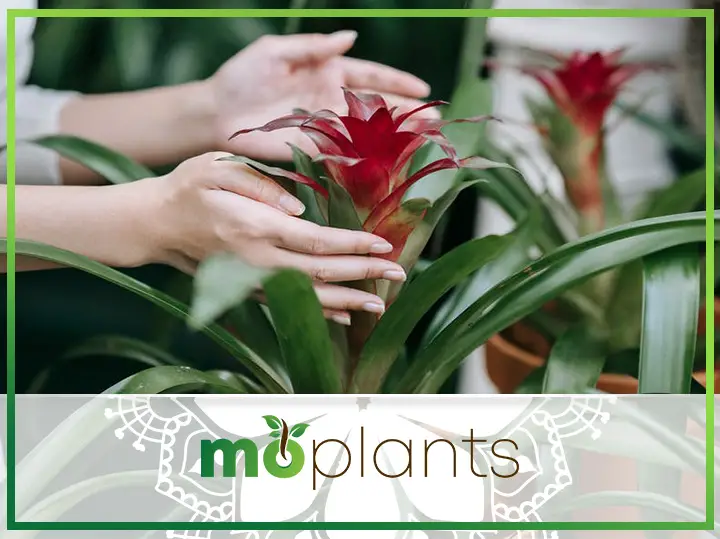The dazzling and captivating bromeliads may look dramatic and high-maintenance, but they are among the easiest plants to grow indoors. These exotic beauties can add color and texture to your interior design with their distinctive shape, ethereal flowers, and spiky leaves. The unusual appearance of your bromeliad plant will make it the envy of everyone who visits your house, stimulating conversations about its otherworldly beauty and your supreme gardening skills.
Though they may look like something out of a science-fiction movie, bromeliads are native to the tropical regions of South America, Central America, and Africa. Some popular houseplant varieties grow well in sun-kissed and humid climates, while others prefer low light and drier conditions. Moreover, in their natural habitat, these splashy flowering plants are either terrestrial or epiphytic.
Bromeliad plants are also tolerant of neglect and highly adaptive to the average home environment. Almost all varieties of this tropical plant only bloom once, but their flower can last for months. The colors of the foliage also vary with each bromeliad type. While some feature strappy leaves in purple, red and green shades, others may have stripes and spots in yellow and orange hues.
Introduction: Bromeliad
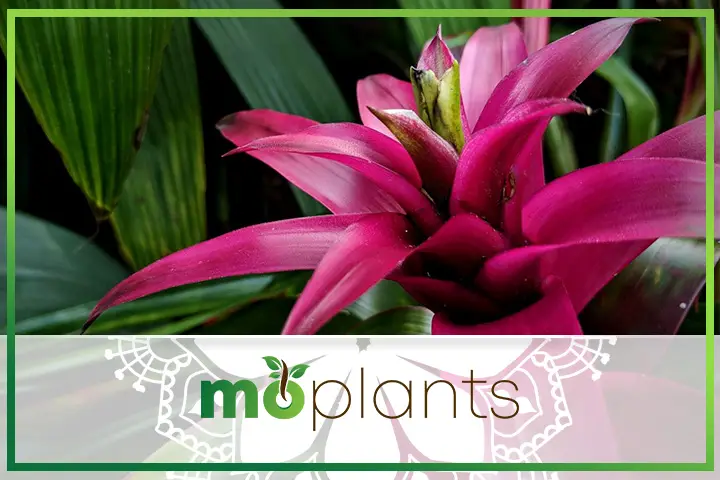
Bromeliad plants are members of the diverse Bromeliaceae family. The plant family comprises over 3000 species in about 57 genera with hundreds of cultivars. Some of the most well-known members of the family include pineapple and Spanish moss, which look nothing like each other. Bromeliads also come in a wide range of shapes and sizes.
These plants typically have thick sword-shaped leaves that grow in a natural rosette formation. However, the most remarkable feature of bromeliads is their striking and highly unusual blooms. From a distance, it may look like a large flower with unique petals. Once you get a little closer, you can see it is a bract surrounding an insignificant flower.
The color of the flora ranges from red and orange to green and purple.
In tropical forests, bromeliads either grow in the soil like other plants or on the bark of trees away from the ground. Even though the roots of these tropical plants help them mount the host trees, they are not parasitic. Instead of extracting nutrients from other vegetation, they absorb moisture from the central “tank” or “cup” in the middle of the plant. This tank catches rainwater and provides sustenance to the bromeliad until all the water either gets absorbed or evaporates.
The plants that grow in the air are called epiphytes. It is also worth mentioning that some of the bromeliad epiphytes can grow in soil like the terrestrial varieties. However, if you want them to thrive, you must get the potting mix and watering frequency right.
The size and age of these plants vary with each genus and variation. Some bromeliads take about a year to flower, while others bloom after three years. In addition, most of these popular houseplants grow at a relatively slow pace. Meanwhile, the height of these plants ranges from an inch to 30 feet, depending on their type and habitat.
Most bromeliads die soon after their flower falls off. However, instead of discarding it right away, you can replant the small offsets that appear near the mother plant to fill your home with exotic foliage. These plantlets are called bromeliad pups.
Besides brightening up your home, bromeliad plants also purify the indoor air by removing toxic chemicals and pollutants. In other words, they are not just pleasing to the eye but also beneficial for your health.
How to Grow Bromeliad Plants
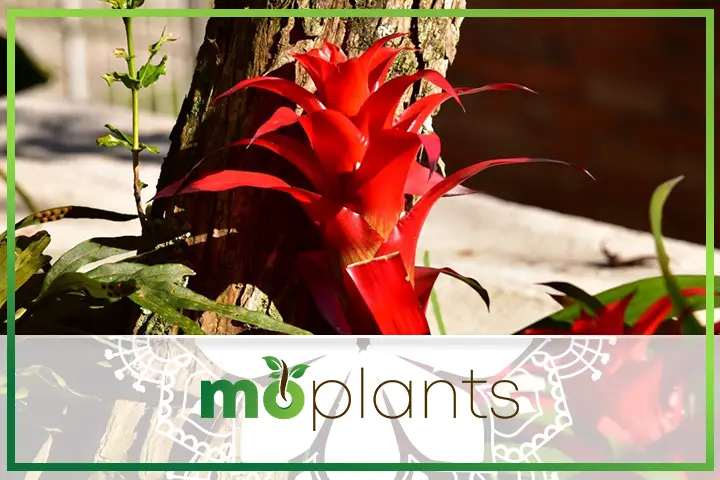
The fascinating appearance of bromeliads may intimidate beginners and brown-thumbed gardeners. However, you’ll be glad to know that growing this plant can be rather effortless.
Here are some tips on how to grow bromeliads indoors that all gardeners will find helpful.
Placement
Bromeliads are hardy plants that can survive pretty much everywhere – as long as you don’t place them under direct sunlight or in front of a cold draft. Indoors, the smaller varieties can flourish on your coffee table or countertop a few feet away from a window.
Ideal Temperature
Most bromeliad types thrive in warm and humid temperatures, while some prefer drier and arid conditions. Typically, these plants are very tolerant of different temperatures. Some cultivars can even survive in cold weather.
If you want your bromeliads to have healthy foliage and produce beautiful flowers, make sure to keep the indoor temperatures between 60 and 85 degrees Fahrenheit. Though some plants can survive in temperatures as low as 20 degrees Fahrenheit, you should try to keep the temperature above 40 degrees Fahrenheit at all times.
Humidity Level
Since they are native to tropical regions, bromeliads grow well in humid environments. Usually, they prosper in 40% to 60% humidity levels. If you live in an area with high humidity, you can even move these plants outdoors during the summer months.
Exposure to Light
Some genera of bromeliads enjoy bright sunlight, while others may turn brown and eventually die if exposed to intense light levels. Therefore, it would be best to find out which bromeliad type you have in your house to find the right balance.
Usually, plants with soft and flexible leaves do well under filtered and low light levels. Meanwhile, bromeliads that have hard and stiff leaves typically prefer bright and indirect light.
Watering Frequency
These hardy plants are forgiving of oversights and negligence. Even if you don’t water them for a couple of weeks, they will continue to thrive as long as the environment is humid.
Ideally, it would help if you watered these beautiful plants every week by filling their central tank with distilled water. Avoid using tap water, as chlorine and other minerals can cause a buildup within the plant. Moreover, you don’t have to keep the tank full of water at all times and let the soil dry between the watering sessions.
It would be best if you also reduce your watering frequency in the winter months.
On the other hand, if you grow bromeliad plants as epiphytes, you can drench them once a day and submerge them in water every week to ensure healthy growth.
Potting Mix
Terrestrial bromeliads prefer slightly acidic and well-draining soil that holds moisture. You can mix orchid and soilless potting mix in equal quantities to grow these plants indoors. However, do not add garden soil to the pot.
As for the epiphyte varieties, you can secure them to logs and boards using ties or glue. Alternatively, you can place them in a decorative container or terrarium with at least one side open for proper ventilation.
Infographic
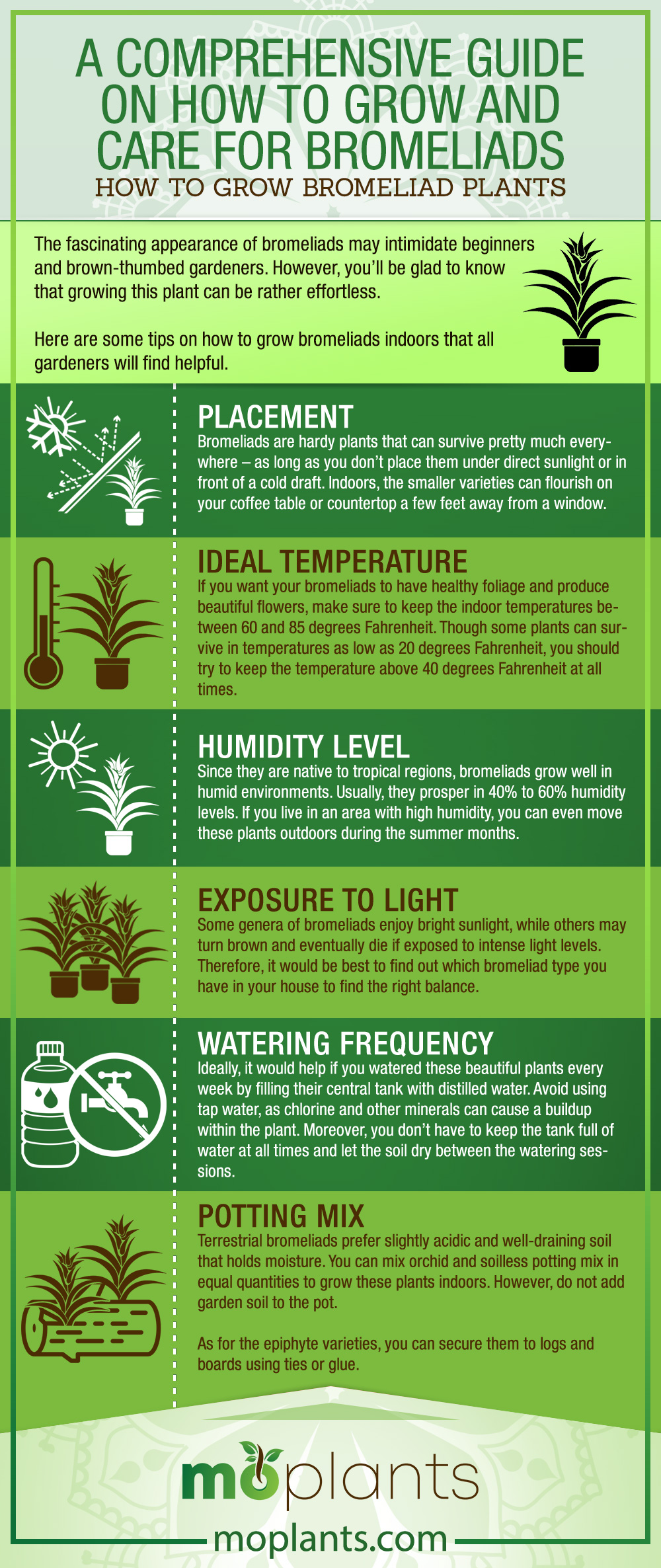
Bromeliad Propagation Method
The bromeliad pups are responsible for continuing the line after the mother plant dies. If the pup can stand independently without relying on the older plant for support and has solid roots, you can gently separate it. It is always good to move the bromeliad pups in a new potting media containing peat moss and perlite.
It will take the baby plant about six to eight months to mature and then a year or two to flower. As mentioned above, some varieties may bloom sooner than others. You can encourage flower growth by placing an apple in the central cup and cover it with a plastic bag. As the fruit ripens, it will release ethylene gas that will help your plant bloom quickly. However, make sure to remove the apple after three weeks.
Bromeliad Care Tips
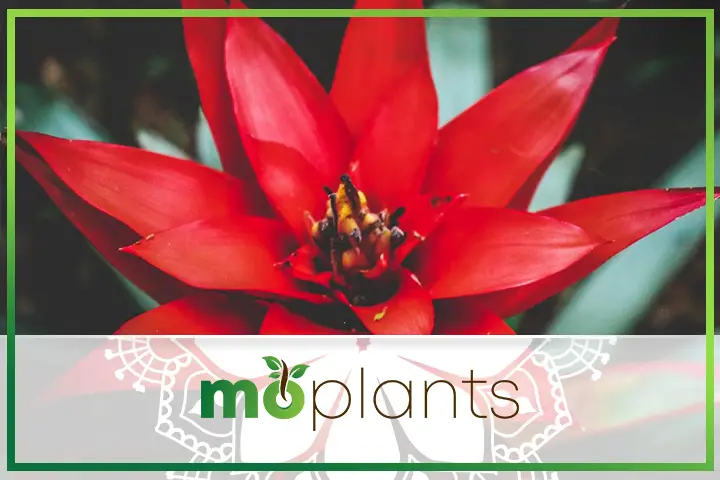
Here are some essential bromeliad care tips that can elongate their lifespan and result in shiny foliage.
Pruning and Trimming
Removing dead leaves can encourage growth. Therefore, if you have noticed any old leaves near the base of your plant or if the mother plant has died after blooming, make sure to prune it away to keep the bromeliad pups healthy.
Please note that some varieties feature spiky leaves, so you must wear protective equipment such as thick rubber gloves before tending to your houseplant. In addition, don’t forget to sterilize your gardening equipment beforehand.
Cleaning the Plant
The best way to remove dust and debris from the foliage is to wipe it with a soft cloth. If there are salt deposits on the leaves, you can spray pineapple or citrus juice on the surface and then rinse the plant with distilled water. This bromeliad care tip will make the foliage look bright and shiny.
Fertilizer
Since bromeliads are not heavy feeders, you can use a diluted liquid fertilizer every two to four weeks to help the plant flourish during the growing season. Additionally, refrain from adding fertilizer to mature plants during the winter months.
Discard Excess Water
Do not let your bromeliads stand in water for too long as it may result in root rot. Every time you water the plant or flush the central tank to remove salt buildup, please make sure to discard the water that accumulates in the saucer beneath the pot.
Choosing the Right Container
You can grow a bromeliad plant in a small container with a four or six-inch diameter. Avoid using a pot that is too large for the plant, as it will allow the potting mix to retain additional moisture, which may damage the roots. It is one of the most critical bromeliad care tips for new gardeners.
Are Bromeliads Toxic?
These beautiful houseplants are not toxic to children and pets alike. While some species have spiky leaves or can potentially trigger allergies, they are not poisonous at all. So, if you have toddlers or furry companions in the house, you can easily decorate your space with these tropical beauties.
Common Bromeliad Problems and How to Solve Them
These are some of the most common issues you may come across while growing bromeliads indoors.
Brown and Drying Leaves
If your plant’s leaves are turning brown and dry, it may indicate a lack of moisture. The best way to troubleshoot this problem is to increase your watering frequency. In case your home has low humidity, consider investing in a humidifier or putting the plant on top of a pebble tray filled with water.
Yellowing Leaves
There are two most common reasons for yellowing leaves: overwatering and insufficient light.
To help your plant become healthy again, please reduce your watering frequency. It would be best if you also waited for the soil to dry before watering it thoroughly. Additionally, move the plant to a warm and sunny location. You should also be careful of direct sunlight, as it can scorch the leaves.
Droopy Leaves
If the leaves of your bromeliad have become soft and droopy, it may be a sign that your plant is thirsty. To solve this problem, mist the foliage every day and increase the humidity level in your home. If you don’t take care of your plant at this stage, it may start shedding soon.
Brown or Soggy Base Leaves
Bromeliads are susceptible to root rot. If the newer leaves look fine while the base leaves are turning mushy and brown, it can be an indication that water has caused damage to the roots of your houseplant. You can try and restore your bromeliad by changing its container and potting mix.
Meanwhile, if you can smell a rotten smell coming from the plant paired with soggy leaves, it could mean the central cup is decaying. Depending on how bad the situation is, you can try your luck with a fungicide. However, it is not easy to save a plant once its roots or center has begun to rot.
Common Pests and Diseases
These charming plants are susceptible to mealybugs and scales, among other pests. Usually, mealybugs appear like a cottony substance attached to the base of the plant. You can solve this problem by dabbing the affected parts of your bromeliad with isopropyl alcohol. Don’t forget to rinse and dry the leaves to get rid of the bugs.
Infographic
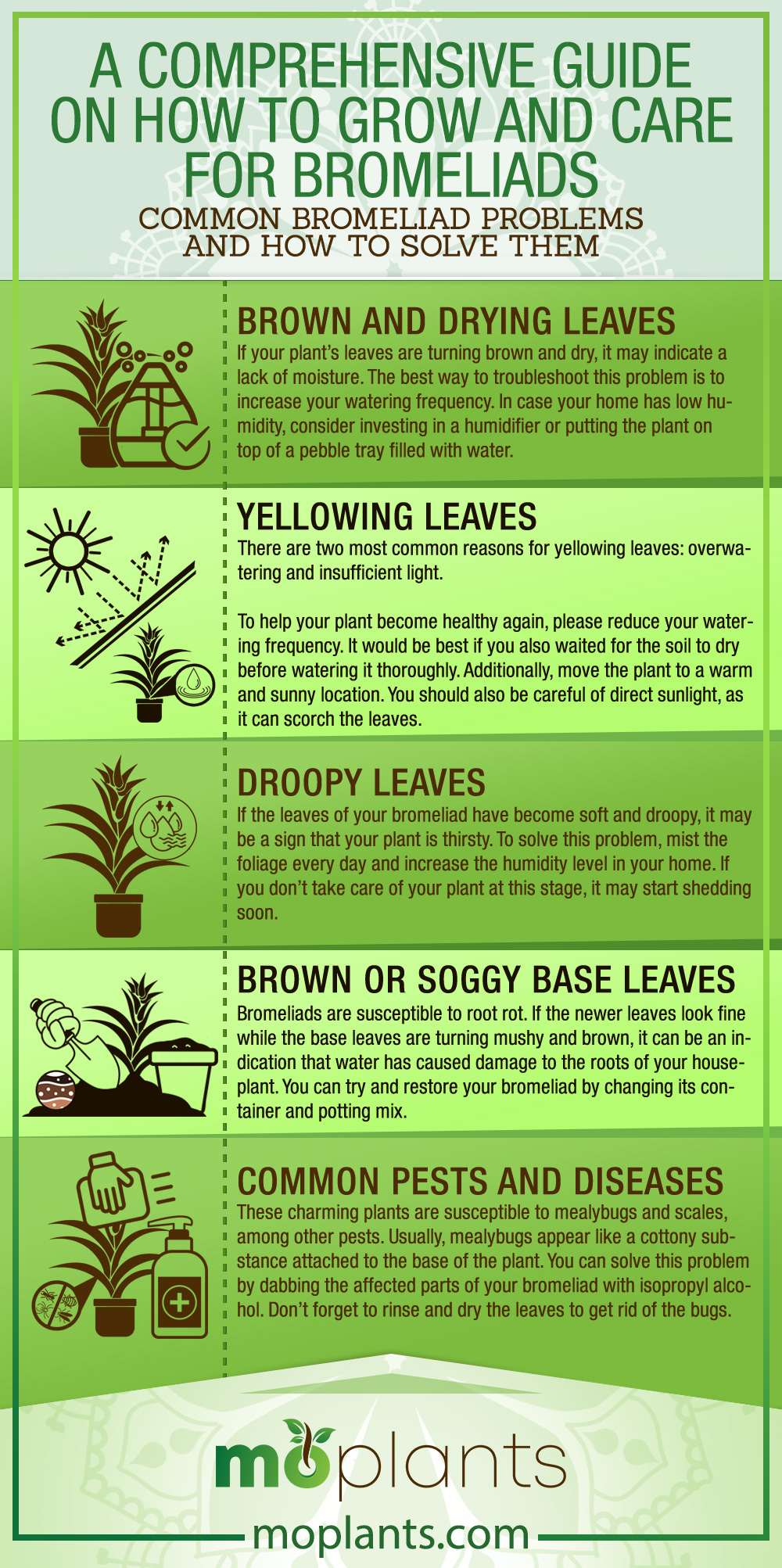
Popular Bromeliad Types
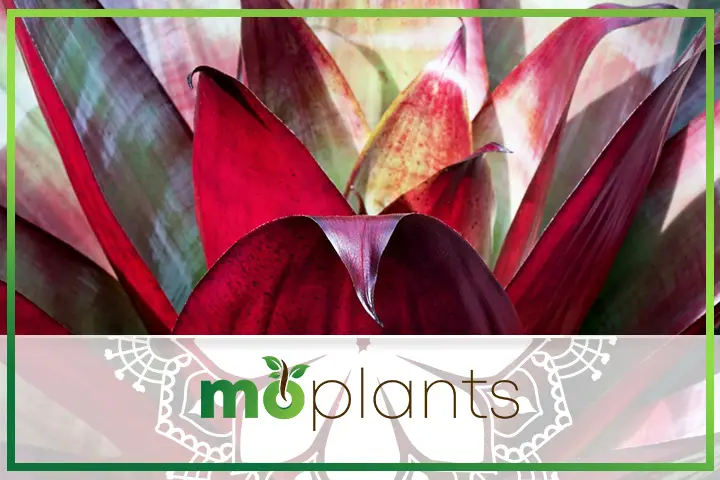
There are different types of bromeliad plants found around the world. Here are some of the most popular indoor varieties that gardeners adore.
Aechmea
Native to subtropical North America, Central America, and South America, it is one of the most beloved and resilient genera of bromeliads. The popular zebra and urn plants are among the most popular species of Aechmea, featuring gorgeous flowers that can last up to six months or more.
Guzmania
Yet another revered bromeliad type, Guzmania features lovely foliage ranging from white and yellow to red to purple. It usually grows up to 24 inches and produces insignificant flowers. Owing to its size and charming colors, Guzmania is the perfect bromeliad variety to place on your table for a chic look.
Neoregelia
These plants don’t have dramatic blooms, but their vibrant foliage more than makes up for it. The Neoregelia plants can survive low temperatures and usually boast narrow, variegated leaves. Moreover, as these plants mature, their central cup turns red and produces tiny flowers. The species in this genus usually grow up to one foot tall.
Vriesea
You may have seen these strange yet breathtaking plants in offices, homes, and hotels. They are generally small and produce colorful flower bracts with small blossoms. The leaves of Vriesea plants are usually variegated. In addition, they thrive in low lights, which make them ideal houseplants. It is also worth mentioning that some Vriesea bromeliads don’t flower at all.
Tillandsia
More commonly known as the air plant, Tillandsia is one of the most well-known genera of bromeliads. These eerie plants are the latest interior design trend, so you can easily find them in any local nursery. Some species of Tillandsia are terrestrial or saxicolous (grow on rocks), but most grow in the air and are thus considered epiphytes.
These unique plants are native to South America.
Bromeliad FAQs
Now that we know all about bromeliad care tips and types, it’s time to look at some of the most frequently asked questions about these exotic plants.
Do bromeliads need sun or shade?
Bromeliads prefer bright but indirect light, which means they grow well in partially shaded locations. However, some varieties may require a sunnier environment to thrive, while others may prefer low lights. The variegated plants usually turn to a solid green color if exposed to intense sunlight.
Do bromeliads only flower once?
Yes, most bromeliad plants only bloom once, but some varieties can produce more than one flower. Typically, bromeliad flowers can last for several months or even up to a year. Also, the bloom time varies with each bromeliad type, as they can pretty much bloom throughout the year.
How often should you water a bromeliad plant?
Watering your bromeliad plant every week is usually sufficient for its growth. These houseplants like moist soil, but overwatering may kill them. The best way to keep your plant alive for a long time is to use soil with proper drainage and a container with an adequate drainage hole at the bottom.
To summarize, bromeliads are one of the fascinating houseplants. Despite their intriguing appearance, these plants require minimal care and attention. They can tolerate almost every temperature and thrive despite the lack of water. However, if you neglect your bromeliad plants for long, they may begin to show signs of distress and eventually die.

